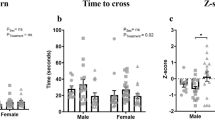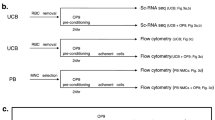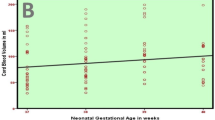Abstract
Autologous umbilical cord blood (UCB) is a possible, but unproven, treatment for acute neonatal brain damage. Mesenchymal stem cells (MSCs), which are present in UCB, are likely to be the treating cell type. UCB is effective in the treatment of neonatal rodent hypoxic–ischemic injury (HI) and other types of brain injury when the cells are delivered acutely. Other types of adult stem cells are similarly effective. However, several negative studies have been reported. The most likely mechanisms of action are participation in blood vessel regeneration, improvement of survival of intrinsic cells, perhaps via neurotrophic factors, or suppression of the release of inflammatory cells from the spleen. In the latter case, the splenic inflammatory cells released at the time of injury are thought to have an adverse effect on brain injury. The timing of the administration of the UCB with respect to the time of the injury appears to be the most important issue: the earlier the better. The risks of autologous administration of UCB are minimal. Current clinical trials with UCB are in progress, but there are no peer-reviewed reports as yet. A multicenter trial with specific inclusion criteria is needed.
Similar content being viewed by others
Log in or create a free account to read this content
Gain free access to this article, as well as selected content from this journal and more on nature.com
or
References
Luo YC, Zhang HT, Cheng HY, Yang ZJ, Dai YW, Xu RX . Differentiation of cryopreserved human umbilical cord blood-derived stromal cells into cells with an oligodendrocyte phenotype. In Vitro Cell Dev Biol Anim 2010;46:585–9.
Lu X, Alshemali S, de Wynter EA, Dickinson AM . Mesenchymal stem cells from CD34(-) human umbilical cord blood. Transfus Med 2010;20:178–84.
Pimentel-Coelho PM, Magalhães ES, Lopes LM, deAzevedo LC, Santiago MF, Mendez-Otero R . Human cord blood transplantation in a neonatal rat model of hypoxic-ischemic brain damage: functional outcome related to neuroprotection in the striatum. Stem Cells Dev 2010;19:351–8.
Xia G, Hong X, Chen X, Lan F, Zhang G, Liao L . Intracerebral transplantation of mesenchymal stem cells derived from human umbilical cord blood alleviates hypoxic ischemic brain injury in rat neonates. J Perinat Med 2010;38:215–21.
Meier C, Middelanis J, Wasielewski B, et al. Spastic paresis after perinatal brain damage in rats is reduced by human cord blood mononuclear cells. Pediatr Res 2006;59:244–9.
Yasuhara T, Hara K, Maki M, et al. Mannitol facilitates neurotrophic factor up-regulation and behavioural recovery in neonatal hypoxic-ischaemic rats with human umbilical cord blood grafts. J Cell Mol Med 2010;14:914–21.
Derrick M, Luo NL, Bregman JC, et al. Preterm fetal hypoxia-ischemia causes hypertonia and motor deficits in the neonatal rabbit: a model for human cerebral palsy? J Neurosci 2004;24:24–34.
Derrick M, Drobyshevsky A, Ji X, et al. Hypoxia-ischemia causes persistent movement deficits in a perinatal rabbit model of cerebral palsy: assessed by a new swim test. Int J Dev Neurosci 2009;27:549–57.
Chen J, Sanberg PR, Li Y, et al. Intravenous administration of human umbilical cord blood reduces behavioral deficits after stroke in rats. Stroke 2001;32:2682–8.
Willing AE, Lixian J, Milliken M, et al. Intravenous versus intrastriatal cord blood administration in a rodent model of stroke. J Neurosci Res 2003;73:296–307.
Vendrame M, Cassady J, Newcomb J, et al. Infusion of human umbilical cord blood cells in a rat model of stroke dose-dependently rescues behavioral deficits and reduces infarct volume. Stroke 2004;35:2390–5.
Borlongan CV, Hadman M, Sanberg CD, Sanberg PR . Central nervous system entry of peripherally injected umbilical cord blood cells is not required for neuroprotection in stroke. Stroke 2004;35:2385–9.
Newcomb JD, Ajmo CT Jr, Sanberg CD, Sanberg PR, Pennypacker KR, Willing AE . Timing of cord blood treatment after experimental stroke determines therapeutic efficacy. Cell Transplant 2006;15:213–23.
Chung DJ, Choi CB, Lee SH, et al. Intraarterially delivered human umbilical cord blood-derived mesenchymal stem cells in canine cerebral ischemia. J Neurosci Res 2009;87:3554–67.
Nan Z, Grande A, Sanberg CD, Sanberg PR, Low WC . Infusion of human umbilical cord blood ameliorates neurologic deficits in rats with hemorrhagic brain injury. Ann N Y Acad Sci 2005;1049:84–96.
Lu D, Sanberg PR, Mahmood A, et al. Intravenous administration of human umbilical cord blood reduces neurological deficit in the rat after traumatic brain injury. Cell Transplant 2002;11:275–81.
de Paula S, Vitola AS, Greggio S, et al. Hemispheric brain injury and behavioral deficits induced by severe neonatal hypoxia-ischemia in rats are not attenuated by intravenous administration of human umbilical cord blood cells. Pediatr Res 2009;65:631–5.
Mäkinen S, Kekarainen T, Nystedt J, et al. Human umbilical cord blood cells do not improve sensorimotor or cognitive outcome following transient middle cerebral artery occlusion in rats. Brain Res 2006;1123:207–15.
Zawadzka M, Lukasiuk K, Machaj EK, Pojda Z, Kaminska B . Lack of migration and neurological benefits after infusion of umbilical cord blood cells in ischemic brain injury. Acta Neurobiol Exp (Wars) 2009;69:46–51.
Riegelsberger UM, Deten A, Pösel C, et al. Intravenous human umbilical cord blood transplantation for stroke: impact on infarct volume and caspase-3-dependent cell death in spontaneously hypertensive rats. Exp Neurol 2011;227:218–23.
Yasuhara T, Hara K, Maki M, et al. Intravenous grafts recapitulate the neurorestoration afforded by intracerebrally delivered multipotent adult progenitor cells in neonatal hypoxic-ischemic rats. J Cereb Blood Flow Metab 2008;28:1804–10.
Jiang Y, Jahagirdar BN, Reinhardt RL, et al. Pluripotency of mesenchymal stem cells derived from adult marrow. Nature 2002;418:41–9.
Carroll JE, Mays RW . Update on stem cell therapy for cerebral palsy. Expert Opin Biol Ther 2011;11:463–71.
Riess P, Zhang C, Saatman KE, et al. Transplanted neural stem cells survive, differentiate, and improve neurological motor function after experimental traumatic brain injury. Neurosurgery 2002;51:1043–52; discussion 1052–4.
Zhao LR, Duan WM, Reyes M, Keene CD, Verfaillie CM, Low WC . Human bone marrow stem cells exhibit neural phenotypes and ameliorate neurological deficits after grafting into the ischemic brain of rats. Exp Neurol 2002;174:11–20.
Peled A, Kollet O, Ponomaryov T, et al. The chemokine SDF-1 activates the integrins LFA-1, VLA-4, and VLA-5 on immature human CD34(+) cells: role in transendothelial/stromal migration and engraftment of NOD/SCID mice. Blood 2000;95:3289–96.
Yamaguchi J, Kusano KF, Masuo O, et al. Stromal cell-derived factor-1 effects on ex vivo expanded endothelial progenitor cell recruitment for ischemic neovascularization. Circulation 2003;107:1322–8.
Rajantie I, Ilmonen M, Alminaite A, Ozerdem U, Alitalo K, Salven P . Adult bone marrow-derived cells recruited during angiogenesis comprise precursors for periendothelial vascular mural cells. Blood 2004;104:2084–6.
Borlongan CV, Lind JG, Dillon-Carter O, et al. Bone marrow grafts restore cerebral blood flow and blood brain barrier in stroke rats. Brain Res 2004;1010:108–16.
Rosenkranz K, Kumbruch S, Lebermann K, et al. The chemokine SDF-1/CXCL12 contributes to the ‘homing’ of umbilical cord blood cells to a hypoxic-ischemic lesion in the rat brain. J Neurosci Res 2010;88:1223–33.
Jiang L, Newman M, Saporta S, et al. MIP-1alpha and MCP-1 Induce Migration of Human Umbilical Cord Blood Cells in Models of Stroke. Curr Neurovasc Res 2008;5:118–24.
Zhang P, Li J, Liu Y, Chen X, Kang Q . Transplanted human embryonic neural stem cells survive, migrate, differentiate and increase endogenous nestin expression in adult rat cortical peri-infarction zone. Neuropathology 2009;29:410–21.
Xiao J, Nan Z, Motooka Y, Low WC . Transplantation of a novel cell line population of umbilical cord blood stem cells ameliorates neurological deficits associated with ischemic brain injury. Stem Cells Dev 2005;14:722–33.
Rowe DD, Leonardo CC, Hall AA, et al. Cord blood administration induces oligodendrocyte survival through alterations in gene expression. Brain Res 2010;1366:172–88.
Vendrame M, Gemma C, de Mesquita D, et al. Anti-inflammatory effects of human cord blood cells in a rat model of stroke. Stem Cells Dev 2005;14:595–604.
Vendrame M, Gemma C, Pennypacker KR, et al. Cord blood rescues stroke-induced changes in splenocyte phenotype and function. Exp Neurol 2006;199:191–200.
Walker PA, Shah SK, Jimenez F, et al. Intravenous multipotent adult progenitor cell therapy for traumatic brain injury: preserving the blood brain barrier via an interaction with splenocytes. Exp Neurol 2010;225:341–52.
Ajmo CT Jr, Collier LA, Leonardo CC, et al. Blockade of adrenoreceptors inhibits the splenic response to stroke. Exp Neurol 2009;218:47–55.
Leonardo CC, Hall AA, Collier LA, Ajmo CT Jr, Willing AE, Pennypacker KR . Human umbilical cord blood cell therapy blocks the morphological change and recruitment of CD11b-expressing, isolectin-binding proinflammatory cells after middle cerebral artery occlusion. J Neurosci Res 2010;88:1213–22.
Sun J, Allison J, McLaughlin C, et al. Differences in quality between privately and publicly bsanked umbilical cord blood units: a pilot study of autologous cord blood infusion in children with acquired neurologic disorders. Transfusion 2010;50:1980–7.
Section on Hematology/Oncology and Section on Allergy/Immunology. Cord blood banking for potential future transplantation. Pediatrics 2007;119:165–70.
Author information
Authors and Affiliations
Corresponding author
Rights and permissions
About this article
Cite this article
Carroll, J. Human cord blood for the hypoxic–ischemic neonate. Pediatr Res 71, 459–463 (2012). https://doi.org/10.1038/pr.2011.53
Received:
Accepted:
Published:
Issue date:
DOI: https://doi.org/10.1038/pr.2011.53
This article is cited by
-
Clinical Utility of Stem Cells in Congenital Anomalies: New Horizons in Pediatric Surgery
Indian Journal of Surgery (2020)
-
Umbilical cord milking reduces the risk of intraventricular hemorrhage in preterm infants born before 32 weeks of gestation
Journal of Perinatology (2019)
-
Implantation of human umbilical cord mesenchymal stem cells for ischemic stroke: perspectives and challenges
Frontiers of Medicine (2015)
-
Neurobiology of premature brain injury
Nature Neuroscience (2014)
-
Stem cells in pediatrics: state of the art and future perspectives
Pediatric Research (2012)



